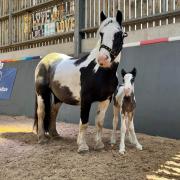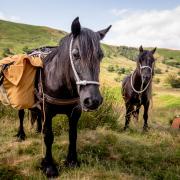Jenny Natusch decided to think small when she quit the rat race for her first love, art. Sue Riley reports

A single grain of sand from Morecambe goes on display this month and if you have £1,000 to spare it could be yours. It forms part of an exhibition of photographs of individual grains of sand by Ormskirk-born artist Jenny Natusch who’s bemused by all the interest in her project which goes on show at London’s Covent Garden. After all, she only started photographing sand as a way of slowing down and reflecting on her life.
Turning 40 and fed up with the rat race – she worked in textiles, TV production and property - Jenny decided to take stock a couple of years ago and spend some time returning to one of her first loves, art. ‘I wanted to look at the beauty of things,’ said the artist, who is based at Halton, near Lancaster.
‘I have gone from having a fast paced life in the rat race. I wanted to slow down and I think there’s a lot of beauty in nature we just miss.’ Jenny thought about times when she had been truly happy and remembered she enjoyed using microscopes as a child.
She invested £6 in a tiny handheld magnifier and her journey began. That led to her buying a more powerful microscope and a camera port to capture single grains.

‘It was a bit of a revelation that nobody had really closely looked at sand apart from a handful of people around the world. I didn’t mean to be still doing it a year later, it’s like a never ending treasure hunt, like indoor beachcombing.’
Her photographs, created without the aid of Photoshop, show the sheer diversity of the sand we tread on and, for the most part, ignore. There are images of sand grains from France resembling miniscule pink and blue sweets, one containing tiny star shaped organisms from Japan and some from the River Thames which look like shards of gold.
‘I can’t quite believe it, it’s funny how these things take off. I’m really not doing any of this for fame and fortune...it’s for my soul. Every grain has its own beauty. Like life, it’s how you look at things. I thought I would have a year off to fathom what I want to do. I wanted to do something I truly loved and not for money. I knew I would start looking at sand but I did not think it would take over my life the way it has,’ she said.
‘I put a message of Facebook for people to send sand to me as I had seen an image on the internet (of a grain of sand by Dr Gary Greenberg in Hawaii) which fascinated me.’ The first package she received was from a distant family member in New Zealand, then more started arriving and now she has 187 samples from all five continents, plus plenty she has collected closer to home such as Morecambe.
Sometimes she likes to illuminate the images by candlelight or uses different backdrops, including seaweed, fire, water or ice. ‘I enjoy the research, it’s like being a bit of a detective,’ said Jenny, a mother-of-one who went to school in Windermere. She particularly wanted sand from Antarctica and through a ‘sand collectors’ page’ on Facebook – yes, several exist as do specialist magazines – a man from Ontario sent her some. In return she sent him some grains from Morecambe. She has to be extremely organised and everything is logged in a book and then each grain she photographs is put in a Perspex container in a numbered bag.
All of her work is done in what was once the broom cupboard of an industrial mill at Halton Mill near Lancaster where her neighbours include academics, artists and a magician. Tiny it may be, but Jenny says: ‘Looking at tiny things makes you have big thoughts,’
Quite by chance, an academic from Lancaster visited her studio and asked her to do an online TEDx talk which went live last year. It was seen by a friend of her mother, who lives in Thornton Cleveleys. He was involved in setting up a new gallery in Covent Garden and said he would love to exhibit her work.
So in June, Jenny will put a couple of dozen magnified images on display together with the grains of sand. The gallery decided to price the individual grains at £1,000 each and Jenny will donate that money to the Family Holiday Association, a charity which gives hard up families a much needed holiday and, as she says, ‘children who have never experienced it before the chance to feel sand beneath their toes.’
More information go to www.sandgazer.com



























